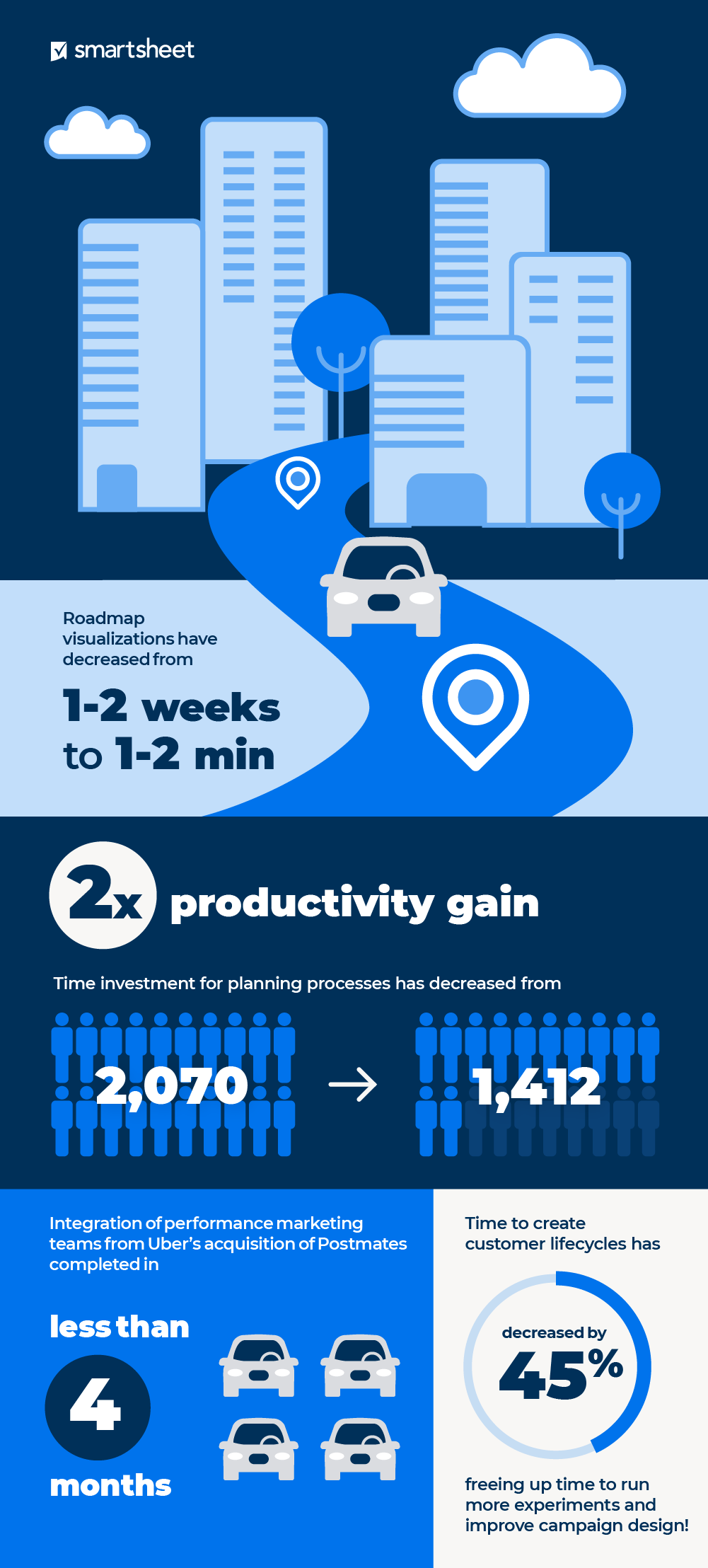Uber cuts planning and lifecycle development time in half, streamlines communication with Smartsheet
With Smartsheet, Uber saves 1,000 staff hours on planning and speeds customer lifecycle development by 40%-45%.

"Our planning process took close to 2,000 person-hours, almost 52 person-weeks. To solve that, we adopted Smartsheet, and were able to cut process time by 50% while relying on a single source of truth for planning, execution, and reporting."
Director of Program Management, Performance Marketing, Uber
Uber has become the global leader in next-hour delivery — for prescriptions, groceries, and food as well as for people who need rides — by making strategic decisions based on a deep understanding of its global markets and customer needs. As the business grew, the Performance Marketing team needed a better workflow platform for managing collaboration to support agile responses to unexpected challenges. Smartsheet provides Uber’s Performance Marketing team with a single platform of record that enables cross-functional communication, automated process management, and visibility across the business.
“We all know 2020 has been a challenging year,” says Bhavik Joshi, Director of Program Management, Performance Marketing at Uber. “Our high-growth delivery business grew even faster during the pandemic. That requires us to be more agile. Investments like the ones we made in Smartsheet on the performance marketing org have allowed us to execute complex programs leveraging a single source of truth for planning, execution, and reporting.”
When Joshi joined Uber in 2018, he saw that the team needed to cut time and manual effort out of its processes. The Performance Marketing organization is made up of cross-functional and technical teams of product managers, engineers, data scientists, marketers and analysts. While the combination of those skills powers tremendous creativity, the teams’ interdependencies mean that a delay for one group can have a ripple effect throughout multiple complex initiatives. Those delays often resulted from reliance on email and spreadsheets to plan and strategize based on fragmented data stores, with no single reliable source of current information.
“Each team was essentially managing the planning, execution and reporting using their own processes and tools,” Joshi says. “This resulted in delays in execution, communication issues, things falling through the cracks, stress, and inefficiencies across the board. I could see that this was not the way we could scale; there needed to be some method to the madness. If we could do it all from a single workflow solution, a single system of record, we could eliminate a lot of those inefficiencies, communication issues and stress that the team was feeling.”
A colleague suggested Smartsheet. Joshi was immediately drawn to its ability to visualize the information in sheet, card view, dashboard, or a roadmap calendar view, to fit each user’s or team’s specific needs. He also saw that with that flexibility and visibility came the power to build accountability across the business.
A platform to cut customer lifecycle creation time by up to 45%
One of the biggest improvements came to the global customer lifecycle development process. Creating a lifecycle used to take as much as three months, but with up to 200 different lifecycles needed over the course of a year, that rate of completion needed to change. Using Smartsheet, Uber cut the process by 40%-45%, while providing clear workflows and top-down visibility into status across the entire CRM org. With the reclaimed time, the team can run more experiments, design better campaigns, and eliminate frustration and lost opportunity.
In keeping with the Uber principles of “show, don’t tell,” Joshi focused on a pilot. His team collaborated with Smartsheet experts to create a proof of concept for the CRM Lifecycle team. After testing and iteration, the solution was built out to become a system of record for the CRM Lifecycle team.
Today the team uses Smartsheet to accelerate campaign development and execution. Control Center enables the creation of automated campaign briefs that map out projects according to templates and send notifications to the right stakeholders throughout the process. Rows of data are automatically relayed into teams’ planning sheets, eliminating the need to create separate Jira tickets for project tracking.
“As part of our healthy impatience initiative, my team helps various teams within our org simplify, standardize and eliminate unnecessary processes, and the workflow engine that we bring to the table in most cases is Smartsheet.”
After Uber acquired Postmates, Joshi and his colleagues were faced with integrating the two companies’ performance marketing teams. They used Smartsheet to map out an integration plan, create progress benchmarks and timeline notifications, and maintain communication with team members and key stakeholders. Automated alerts made it easy to share information with teams whose tasks depended on the integration’s progress, such as brand marketing and community operations.
Replacing email information pushing with real-time dashboards to pull data
Uber also uses Smartsheet dashboards to simplify communication and make key data available to leadership and stakeholders in real time.
“We have complex programs that involve multiple teams, where the timelines are extremely aggressive,” Joshi says. “When new priorities got in the way, keeping all teams on the same page was quite the challenge. A lot of our information-sharing was us pushing information, which may or may not land with the right audience. So we thought, why not also include pull, where the intended audience could always pull information when they wanted, in a self-serve manner, and the most current information is available at their fingertips.”
Dashboards also help keep service level agreements (SLAs) for cross-functional teams visible and on track. Joshi says the program dashboards include red-yellow-green status displays for SLAs so users can tell at a glance whether specific items are behind schedule and can follow up directly. The visual display keeps teams aware of their own performance, as well as putting pressure on them to meet their timelines.
“Before, that real-time visibility did not exist,” Joshi says. “Now that has become the central dashboard for the weekly health check meeting. The team is having much more meaningful conversations; there are far fewer slippages of SLAs; and now everybody knows that data is right there, you can’t hide.”
Slack integration also helps simplify communication. When one user updates a deadline, the teams dependent on that task are alerted via a Slack channel notification.
Finding ways to use the “smarts” as well as the sheets
Another Smartsheet product helping drive efficiency for Uber’s performance marketing team is WorkApps. The no-code platform makes it easy to create purpose-built custom apps that can be tailored to the business and even designed with brand colors and logos. Using WorkApps, Joshi and his team can create role-tailored workspaces that provide the sheets, dashboards, and reports individuals need in a single location.
Joshi and his team are creating a variety of WorkApps to solve workflow inefficiencies for teams within the performance marketing group. Because it’s simple to use — Joshi says the learning curve is “nonexistent” — the team has been able to quickly design and build apps to solve their key problems.
“Before WorkApps, we would share a sheet or a dashboard with people who contribute information,” Joshi says. “But it was all or nothing; there was not much we could do to provide visibility only to certain assets. Now we can customize that access based on roles. It’s nicely contained; it’s neat. I don’t have to bookmark pages, or figure out which of the zillion tabs I have open is the one that I need.”
One of Joshi’s major goals is to expand ongoing Smartsheet adoption and training at Uber. He sees the powerful capabilities of the platform extending far beyond marketing, with integrations for resource management, creative proofing, and more. A more concerted training effort, he says, should lead not just to wider adoption but deeper innovation.
“Most of the users end up using the sheet part of Smartsheet, but not the smarts,” Joshi says. “So I want to level up the users: How do we expose the smarts in Smartsheet? I’d love to see a wider user base proactively think of solving their needs using Smartsheet. I don’t think it’s possible unless they’ve been exposed to all of the capabilities, so I’ll be leveraging the Smartsheet customer success team to turn our colleagues into power users.”
For more information about this story, please see our case study.













